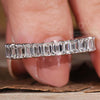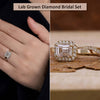
The Evolution of the Lab Grown Diamond
Table Of Contents
- When Were Lab Diamonds First Created?
- Where Was the First Batch of Lab Diamonds Created?
- Who First Invented the Lab Diamond Creation Process?
- How Were Lab Diamonds Previously Made in the Past?
- How Did Lab Diamond Synthesizing Change Over the Years?
- How Are Lab Diamonds Made Now?
- How Has the Supply and Demand for Lab Diamonds Changed?
- Some Lab Created Diamond Jewelry You Might Like
- In Conclusion
Considering how great diamonds are, it is only right if everyone gets to try them on. Waiting for natural diamonds to adorn everyone’s jewelry might be a pipedream, which is why lab grown diamonds are so popular. Taking something so precious from the environment and recreating it is no small feat, and thus, man made diamond jewelry is not only a way to meet the demand for gemstones but also evidence of human caliber.
Diamondrensu is a popular name in lab created diamonds that you should check out if you have trouble believing in the wonders of cultured diamonds. The collection of engagement rings with lab grown diamonds is worth a browse if you plan on popping the question soon.
When Were Lab Diamonds First Created?
Today, there is no lack of lab grown diamond as loose stones and fine jewelry. However, this was not always the case. Even though evidence points to diamonds being discovered in the 4th century BCE India, scientists could not determine their nature until 1797.
Once it was confirmed that diamonds were pure carbon deposits found around 90 miles into the earth’s crust, the race to recreate it started. Owing to the lack of scientific advancement and unfavorable social conditions, the formation of diamonds in lab settings took a while. Throughout the 19th century, many claimed to have synthetically created the perfect diamond, but most of these products did not hold a candle to the naturally mined diamond.
Various projects for the replication of diamonds were kickstarted in the 1940s, but they were postponed due the World War II. It was in 1954 that scientists were able to perfect the ‘recipe’ for the best man made diamond so far.
Where Was the First Batch of Lab Diamonds Created?
The first batch of lab grown diamonds was created in the labs of General Electrics. During the 1940s, General Electrics had assembled a team to replicate the diamond, and the General Electric Research Laboratory in Schenectady in New York was their operation site.
For synthetic diamond research, various chemistry, physics, and industrial engineering experts were brought together. The project was highly confidential and was named ‘Project Super pressure.’ As groundbreaking as the first replication of diamonds was, it was soon understood that these lab grown loose diamonds could be used commercially. Later, the first gem-quality crystals were formed by General Electrics in 1971.
Who First Invented the Lab Diamond Creation Process?
The invention of lab grown diamonds is accredited to the team at General Electrics, consisting of Francis Bund, Herbert Strong, Howard Tracy Hall, Robert Wentorf, and James Cheney, and was managed by Anthony Nerad. These leading members of ‘Project Super pressure’ drew their inspiration back from Lavoisier and Tennent’s experiments.
Henri Moissan, and Parsons are other important names in the journey to perfecting the experimental settings and equipment for creating diamonds in labs. American Nobel-winning physicist Percy Bridgman also made a notable contribution to the process of creating cultured diamonds. These names need equal mention while discussing lab diamond creation processes because Rome was not built in a day, and neither was the first man-made diamond.
How Were Lab Diamonds Previously Made in the Past?
From the earliest attempts to recreate the diamond, it was evident that subjecting carbon to high heat and pressure was the only solution. However, doing so in laboratory conditions proved to be highly risky. In fact, Percy Bridgman’s vertical hydraulic piston that pressed into a cylinder, which created 4,200 atmospheres of pressure, led the canister to blow up and was termed ‘The Bomb.’ The Harvard lab is said to have preserved the holes in the memory of Bridgman’s work.
At General Electrics, numerous attempts were made to produce lab grown diamonds. The project took so much time and resources that it became a monetary sinkhole for the company. Fortunately, Experiment 151 that the team ran yielded positive results that set forth the creation of man-made diamond jewelry.
The procedure that led to the first lab created diamonds is known as the High Pressure High Temperature or the HPHT method. It starts by placing a small diamond, often termed the ‘diamond seed,’ into carbon. This seed is then subjected to high pressure of approximately 1.5 million pounds per square inch using equipment such as a belt press or cubic press. In this state, the temperature is kept at over 2,700°F, and the carbon begins to melt. Once the carbon melts all around the seed diamond, lab grown diamonds as loose stones can be collected when it cools.
How Did Lab Diamond Synthesizing Change Over the Years?
Various labs have been engaged in creating the perfect synthetic diamond for years. Even from the very start, the High Pressure/High Temperature technique was used in variations in labs across the world, only Allmänna Svenska Elektriska Aktiebolaget Laboratory in Stockholm, Sweden, and the General Electricals researchers were able to get the right conditions around the same time.
Then, the HPHT method was the only reliable option for diamond synthesis. This method had its own limitations, such as limited control of impurities and an upper limit to the size of the diamond that can be produced.
An alternative to the HPHT was soon designed by a start-up company in Boston called Apollo Diamond. They found a low-pressure technique called Chemical Vapor Deposition (CVD), which opened up more avenues in the production of cultured diamonds.
How Are Lab Diamonds Made Now?
CVD is still the most commonly used production technique for lab grown diamonds. This method is highly favored because it can grow larger diamonds and is less expensive than the conventional high-pressure, high-temperature methods. Most of the time, CVD is used to create single-crystal diamond wafers that are sizeable enough to be cut into diamond gemstones of a carat or more later.
Being able to control the impurities that get caught in the diamond is one of the most appreciated benefits of CVD over HPHT. Thanks to this, experts can control the color of the diamond created. Unlike before, not only colorless but pink, blue, honey brown, and even black can also be created now.
How Has the Supply and Demand for Lab Diamonds Changed?
When starting out, lab grown diamond jewelry was not as popular as natural jewelry. Traditionalists chose mined diamonds over ‘fake’ diamonds, and there was a period when synthetic diamonds were more popular in industrial equipment rather than jewelry. With time, consumers started seeking out ethically sourced and environment-friendly sustainable jewelry.
Since synthetic diamonds cost only a fraction of natural diamonds, they are endeared to those on a budget. As of now, lab grown diamonds make up a greater portion of the diamond market than mined ones. With the younger generations becoming aware of the impact that diamond has on multiple facets, they are actively advocating the use of cultured gemstones.
Some Lab Created Diamond Jewelry You Might Like

If you are looking for a pair of earrings that can work in any setting, these diamond earring studs are a great choice. Functional and elegant at the same time, these traditional round cut stones can bring a lovely radiance to any outfit you choose. Be it an anniversary, birthday, or Mother’s Day, these earrings with a warm hug are a gift you can put together at the last minute without appearing thoughtless.

A simple diamond pendant can add another layer of sophistication to your look, no matter where you are. If you need to go from a day at the office to date night in a matter of minutes, this elegant pear cut diamond can be just the accessory you need.

If you are looking for an engagement ring that will bring awed gasps from anyone who comes across it, this ring with 2.50-carat oval cut diamond set in the center is an ideal choice. With a hidden halo of round cut brilliant diamonds, this engagement will look lovely on your partner’s arms as a symbol of your love.

When it comes to wedding rings, an eternity band is an interesting choice. This lab diamond wedding band comes with the sparkling beauty of a round brilliant cut diamond wrapped around the shank. This beauty is going to be a memorable part of your wedding day and every day since.
Diamond rings are incredible, but what if you need something personalized? Lab grown loose diamonds is something that you should look into if you need a unique engagement or wedding ring. Diamondrensu gives you an opportunity to create your own design instead of sticking to highly common designs.
In Conclusion
If you are keen on using diamonds, using lab created diamonds is the best option today. Being sustainable, ethical, and unique, synthetic diamonds are a way to create elegant jewelry.
Leave a comment
Please note, comments must be approved before they are published.


















